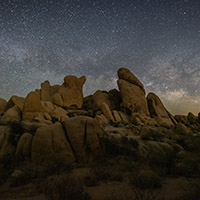Video: Canon offers quick tips to help you capture excellent night sky photos
posted Friday, August 26, 2022 at 1:00 PM EDT

In the latest "Canon Quick Tips" video, Canon senior technical specialist Mason Higa shares some great tips for selecting gear and dialing in camera settings for night sky and astrophotography.
In the video below, Higa uses a Canon EOS R6 and RF 15-35mm F2.8L IS USM lens. Higa picked the R6 because its 20MP full-frame image sensor performs extremely well in low light. Of course, to do night sky photography, you don't need a full-frame camera or one with a relatively low megapixel count. Micro Four Thirds and APS-C cameras can also capture beautiful night sky images, although image quality may not be quite as good as what you could achieve with a full-frame camera, all else equal.
As for the lens, an F2.8 lens works well for night sky photography. You want as much light coming through the lens as possible. You also typically want a wide-angle lens to show as many stars as possible. To learn more about the best lenses for night sky photography, read our "The best astrophotography lenses for your mirrorless camera" guide. Further, the wider your focal length, the longer your shutter can be without stars appearing blurry in the sky. To determine the ideal shutter speed for a given image sensor, megapixel count, and focal length, check out Lonely Speck's Advanced Astrophotography Shutter Time Calculator.
Beyond picking the right camera and lens, it's critical that you have a sturdy tripod. Any camera shake will be bad news for your night sky photos. Similarly, you want to use a remote control. In a pinch, your camera's self-timer also works well.
As for camera settings, Higa recommends shooting in manual mode. Your camera won't be able to meter as well at night, and you must correct for star trails, so you want total control over your camera's shutter speed, aperture and ISO to ensure a good exposure with sharp stars. It's important to evaluate exposure by looking at the histogram on your camera since night sky images will look very bright to you at night but may be very underexposed when you view them on your computer later. Shooting in a raw file format is important because you'll want flexibility when doing post-processing. Your camera may have long exposure noise reduction enabled by default. Higa recommends turning it off because it will double the time it takes to capture a single image.
(Via Canon USA)